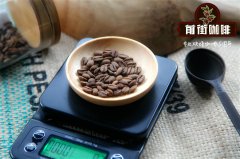How do you grade the coffee? What is pb/g1/g2?
When buying coffee beans, in addition to the name of the coffee origin in the package or in the introduction, sometimes you will see the English and numbers, G1, G2, G3, AA, PB, SHB, SHG, HB and so on. Have you ever wondered what these English or numbers stand for? What's the difference between them?
In order to distinguish between good quality coffee beans and poor quality coffee beans, manufacturers have to grade coffee. Coffee grading is usually carried out according to defect rate, bean size, altitude, raw bean density, treatment standards, etc., but because each country's historical background, trade interests, climate, topography and other factors are different, we cannot use the same standard to calculate defects, or simply to compare heroes in terms of altitude, nor can we compare one country with another. These are all mistakes rather than objective direct comparisons. Therefore, in more cases, it is a combination of a variety of standards for description, and in order to really understand these English and figures, we have to understand the classification and classification of coffee.
Classification and Classification of Coffee
In different countries, there will be their own accustomed way of grading. But basically, the most commonly used grading criteria are as follows:
1. Differences in the appearance of raw beans, such as size, shape, defect ratio.
two。 The environment in which raw beans grow and their effects, such as altitude and hardness.
3. After baking, it is judged by the quality of the cup.
As a result, coffee beans are graded according to some key points before they are processed for export:
① according to the proportion of defective beans
② by legume size
③ altitude and hardness
Quality test by ④ cup
The proportion of ① defective beans the less the proportion of defective beans, the higher the grade of beans, generally speaking, the producing area and the store will pick beans according to the condition of beans. (riddle Voice: picking out defective beans is a very time-consuming and time-consuming task.) for example, Ethiopia's raw beans are G1~G5, G1 and G2 are washing grades, G3 and G4 are sun grades, and general commercial beans are G4. (in recent years, the preferred grades of many Ethiopian sun beans are also marked with G1 and G2. )
Jiayushan Mantenin grade is G1, natural shade planted high-quality Arabica beans, washing treatment.
Classification according to defect rate American standard USP (US preparation), European standard EP (Euro preparation), top quality standard GP (Gourmet preparation) many countries have USP, EP and GP standards, USPEP is relatively more common. European and American standards are based on the specific requirements for the defects or items of raw beans, and sometimes there are other standards among them, which are not detailed because different national standards are different. Generally speaking, the EP standard is higher than the USP standard.
② according to the size of the bean, that is, the length and width of the bean body (size), Colombia takes "bean size is beauty" as the purpose, grading is based on the order, more than 18 mesh (about 0.7cm) is Supremo, and the following is Excelso. (item represents the diameter of coffee beans, one item is 1x64 inch, 1 inch = 25.4mm.) Kenya's grading is based on bean size, supplemented by cup quality and bean weight. So we often hear of Kenya AA, the highest quality grade is AA PLUS (AA+), followed by AA and AB (1516 orders, accounting for the majority of production). Wait. In addition, there is PB, which means Peaberry, which is classified by appearance.
For information, please follow the coffee workshop (Wechat official account cafe_style)
Important Notice :
前街咖啡 FrontStreet Coffee has moved to new addredd:
FrontStreet Coffee Address: 315,Donghua East Road,GuangZhou
Tel:020 38364473
- Prev

Buy a drink and sit all day. Are you an Olympic guest? The rule of Taiwan cafes is low, which is the rule of Polish bosses.
Professional coffee knowledge exchange more coffee bean information Please follow the coffee workshop (Wechat official account cafe_style) recently read an online news article in Taiwan with third-grade students, mainly saying that in this customer-oriented era, because each service staff wants to meet the needs of consumers as much as possible, so unwittingly cultivate a lot of "Olympic guest"
- Next

Brazilian coffee, Brazil is a big coffee country in the world.
Brazilian coffee generally refers to coffee produced in Brazil. There is a wide variety of Brazilian coffee, the vast majority of which are unwashed and sun-dried, classified according to the name of the state of origin and the port of transport. Brazil has 21 states and 17 states produce coffee, but four of them produce the largest, accounting for 98% of the country's total output. Brazilian coffee has a low sour taste, which goes well with coffee.
Related
- What documents do you need to go through to open a coffee shop? coffee shop coffee shop certificate processing process
- How to purchase Coffee beans in small Cafe how to choose a suitable supplier for domestic Coffee supply Company
- How to drink Starbucks Fragrance White Coffee? how to make Australian White Coffee? what Italian coffee beans are recommended?
- The Story of Flora Coffee: the name of Flora Coffee Bean and the implication of the Flowers on Florna Coffee
- How much does a cup of coffee cost? How much is the profit of a cup of coffee? What is the profit of the coffee shop in a year?
- Yunnan small Coffee, known as "fragrant Coffee", introduces the characteristics of Alpine Arabica Coffee producing areas in Yunnan, China
- 2023 latest Starbucks full menu price list how much is a cup of Starbucks coffee what is better to drink the most popular hot and cold drinks recommended
- Starbucks different kinds of Coffee Price list Starbucks menu 2023 Top Ten Best drinks in Starbucks
- Starbucks Spring praise Comprehensive matching Coffee Bean theme Story Packaging implication and taste description
- The cost of a cup of coffee latte American coffee cost price and selling price

